by Amineddoleh & Associates LLC | Mar 5, 2024 |
In honor of International Women’s Day and Women’s History Month, our firm is reposting one of our favorite blog posts. This post originally ran on our firm’s blog in 2021.
—
It is a bitter truth that women, who are so often depicted, admired and romanticized through art, have had to overcome herculean obstacles to participate in its creation. In honor of Women’s History Month, this entry in our Provenance Series examines the work of the Old Masters’ female counterparts – the Old Mistresses – and their contemporary successors.
Rediscovery of Female Artists
Renaissance and Baroque works by women have deservedly entered the public consciousness in recent years. In 2019, a depiction of the Last Supper by nun Plautilla Nelli was installed in the Santa Maria Novella Museum in Florence, after a painstaking 4-year restoration by the Advancing Women Artists Foundation (AWA). The project was made possible through the AWA’s “adopt an apostle” crowdsourcing program: private financiers were allowed to “adopt” one of the life-sized disciples at $10,000 each (ever-unpopular Judas was instead funded by 10 backers at only $1,000 each). The oil painting, measuring 21 feet across, is one of the largest Renaissance works by a female artist still in existence. It is also the only work created by a woman during the Renaissance depicting the Last Supper.

Last Supper by Plautilla Nelli (prior to restoration). Image via My Modern Met.
The Provenance and Restoration of Plautilla Nelli’s The Last Supper
The Last Supper was likely created for the benefit of Plautilla’s own convent, the convent of Santa Caterina di Cafaggio in Florence, where it hung in the refectory (dining hall) until the Napoleonic suppression in the 19th century, when the convent was dissolved. It was thereafter acquired by the Florentine Monastery of Santa Maria Novella in 1817. Again, it was housed in the refectory until being moved to a new location in 1865. Scholar Giovanna Pierattini reports it was moved to storage in 1911, where it remained until 1939. It then underwent significant restoration, and returned to the refectory. It would remain on display there for almost forty years, surviving the historic flood of the Arno in 1966 with little damage. The work was next taken down in 1982, when the refectory was reclassified as the Santa Maria Novella Museum, and transferred to the friars’ private rooms. This is how the monumental work, which remained out of the public eye for centuries, is now visible to the public for the first time in 450 years.
Rossella Lari, the restoration’s head conservator remarks, “We restored the canvas and, while doing so, rediscovered Nelli’s story and her personality. She had powerful brushstrokes and loaded her brushes with paint.” The painting features emotionally charged expressions, emphatic body language, and exquisite details, such as the inclusion of customary Tuscan cuisine (roasted lamb and fava beans).
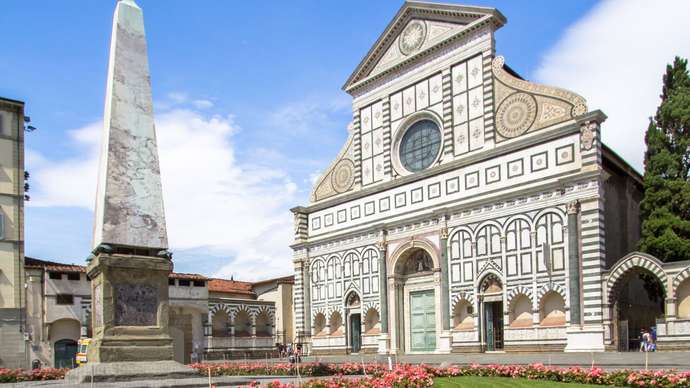
Santa Maria Novella in Florence, Italy. Image courtesy of CAHKT/iStock.com.
Plautilla’s use of color and composition is even more impressive when one considers that women were barred from attending art schools and studying the male nude; instead, they were forced to rely on printed manuals and the works of other artists. Plautilla was not only a self-taught artist, but she also ran an all-woman workshop in her convent and received the ultimate praise for an Italian Renaissance painter: inclusion in Giorgio Vasari’s seminal book Lives of the Most Excellent Painters, Sculptors and Architects. Notably, in Plautilla’s time the convent was managed by Dominican friars previously under the leadership of fire-and-brimstone preacher Girolamo Savonarola. The nuns were encouraged to paint devotional pictures in order to ward off sloth.
Undeterred, “Plautilla knew what she wanted and had control enough of her craft to achieve it,” says Lari. The Last Supper is signed “Sister Plautilla – Orate pro pictora” (“pray for the paintress”). Plautilla thus confirmed her role as an artist while acknowledging her gender, understanding that the two were not mutually exclusive. Although only a handful of the works survive today, Plautilla and her disciples created dozens of large-scale paintings, wood lunettes, book illustrations, and drawings with great focus, determination, and discipline. She is considered the first true woman artist in Florence and in her heyday, “There were so many of her paintings in the houses of gentlemen in Florence, it would be tedious to mention them all.” Since AWA’s conservation work was initiated, the number of works attributed to Plautilla has risen from three to twenty, meaning that other undiscovered masterpieces could be lying in wait.
Female-Led Museum Exhibitions
The Prado Museum in Madrid has hosted an exhibition featuring two overlooked Baroque painters, Sofonisba Anguissola and Lavinia Fontana, in an exhibition entitled “A Tale of Two Women Painters.” Meanwhile, the National Gallery in London hosted a show dedicated to Artemisia Gentileschi. Notably, Sofonisba, Lavinia and Artemisia all achieved fame and renown during their lifetimes, including royal commissions, only to be eclipsed for centuries after their deaths. Sofonisba was particularly sought after for her ability to capture the expressiveness of children and adolescents in intimate portraits, while Lavinia’s commissions displayed a more formal Mannerist style. Artemisia, the subject of the National Gallery’s first major solo show dedicated to the artist, is recognized as much for the strength of her figures in chiaroscuro as for her life story involving sexual assault and trial by torture. Despite considerable difficulties, Artemisia was able to succeed in a male-dominated field and created over 60 works, most of which feature women in positions of power. Artemisia is now hailed as one of the most important painters of her generation and an established Old Mistress in her own right.
Female Artists at Auction
Despite their long slumber in the annals of history, these artists are not only receiving attention in museums, but in auctions as well. In 2019, a painting by Artemisia depicting Roman noblewoman Lucretia shattered records when it sold for more than six times its estimated price at Artcurial in Paris. While estimates originally placed the work at $770,000 to $1 million, the painting was ultimately acquired by a private collector for $6.1 million. Lucretia was discovered in a private art collection in Lyon after remaining unrecognized for 40 years. It was in an “exceptional” state of conservation according to Eric Turquin, an art expert specializing in Old Master paintings previously at Sotheby’s.

Artemisia Gentileschi’s Lucretia (ca. 1630-1640). Image via Getty Museum.
The earlier record for one of Artemisia’s works had been set in 2017, when a painting depicting Saint Catherine sold for $3.6 million. That painting, a self-portrait of the artist, was then acquired by the National Gallery in London for $4.7 million in 2018. This was the first painting by a female artist acquired by the National Gallery since 1991, and the 21st such item in its entire collection, which encompasses thousands of objects. Saint Catherine had been owned by a French family for decades, but its authorship was obscured prior to its rediscovery and sale by auctioneer Christophe Joron-Derem. The painting was acquired by the Boudeville family in the 1930s, but the exact circumstances of this acquisition and the painting’s prior whereabouts were unclear. At the time of the National Gallery’s purchase, museum trustees raised concerns that the work might have been looted during World War II, although there is no firm evidence to support this suspicion. Despite the gaps in the works’ provenance, it was ultimately determined that the painting had been with the family for several generations and Saint Catherine was welcomed to her new home in London.
Recent Attributions
More recently, a painting of David and Goliath was attributed to Artemisia after a conservation studio in London removed layers of dirt, varnish and overpainting to reveal her signature on David’s sword. While the work’s attribution occurred too late for inclusion in the National Gallery exhibition, the owner is apparently delighted to discover the work’s true author and is keen to loan it to an art institution so the public can enjoy the work. This painting was originally acquired at auction for $113,000 and may have been owned by King Charles I – quite an esteemed pedigree and sure to raise its value by a considerable amount.
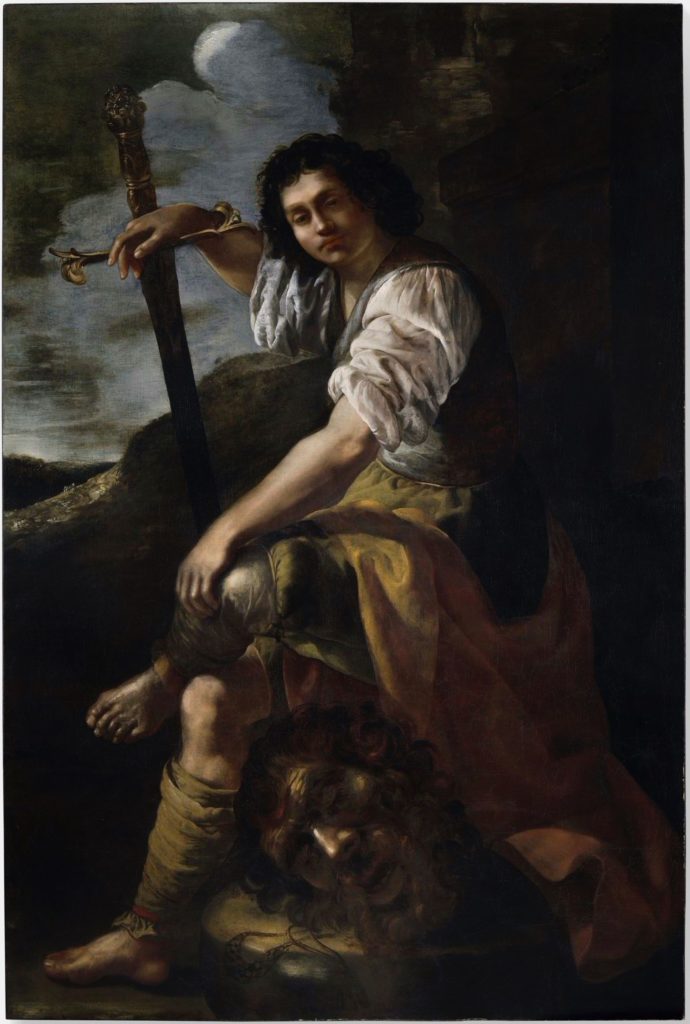
Artemisia Gentileschi, David and Goliath. Image courtesy of Simon Gillespie Studio.
In contrast to Artemisia’s ascendance, a painting once attributed to her father Orazio Gentileschi is now embroiled in controversy. That painting, which also depicts David and Goliath and described as “stunning” by the Artemisia show curator, has links to notorious French dealer Giuliano Ruffini. Ruffini is the subject of an arrest warrant due to his connection with a high-profile Old Master forgery ring operating in Europe. It is believed that the forgery ring, uncovered in 2016, garnered $255 million in sales, including works represented as being by Lucas Cranach the Elder and Parmigianino.
Although these paintings were widely accepted as genuine masterpieces and fooled leading specialists, they did not have verifiable provenances. The paintings were said to belong to private collector André Borie, although that was not the case and Sotheby’s was forced to refund money to buyers once the fraud came to light. The Gentileschi in question had been “discovered” in 2012 and sold to a private collector, who loaned it to the National Gallery in London. At that time, the painting was praised for its “remarkable” lapis lazuli background, but the museum did not conduct a technical analysis before displaying the piece. Despite several warning signs – the painting’s recent entrance into the art market, its unusual material, its similarity to another Gentileschi painting held in Berlin, and the lack of published provenance – the museum stated that there were “no obvious reasons to doubt” the painting’s attribution.
The forgotten nature of some female artists demonstrates that their talents are not rare, but rather that they lack the opportunities and publicity that male artists often take for granted. Once their talent is amplified, female artists are capable of great things. This pattern continues today.
The Modern Struggles of Female Artists
As famous female artists lost to history capture the public eye, they are joined by female contemporaries who share a similar struggle against underrepresentation. Women’s contribution to modern and contemporary art is often exemplifiedby those with ties to established male artists: Mary Cassatt (who achieved recognition as an Impressionist in Paris through her relationship with Edgar Degas); Georgia O’Keeffe (who entered the public eye via her relationship to Alfred Stieglitz); and Frida Kahlo (introduced to the art world by her husband, Diego Rivera). This truncated view ignores the vast amount of creative output generated by women, and reinforces the notion that recognition must be made through a male lens, a view prevalent during Artemisia’s time. It is worth noting that Artemisia’s father Orazio Gentileschi was her teacher and facilitator in the Baroque art market. In fact, this attitude has denied countless female artists of their deserving places in the canon of art history. It has even enabled surreptitious artists to take credit for works by others.
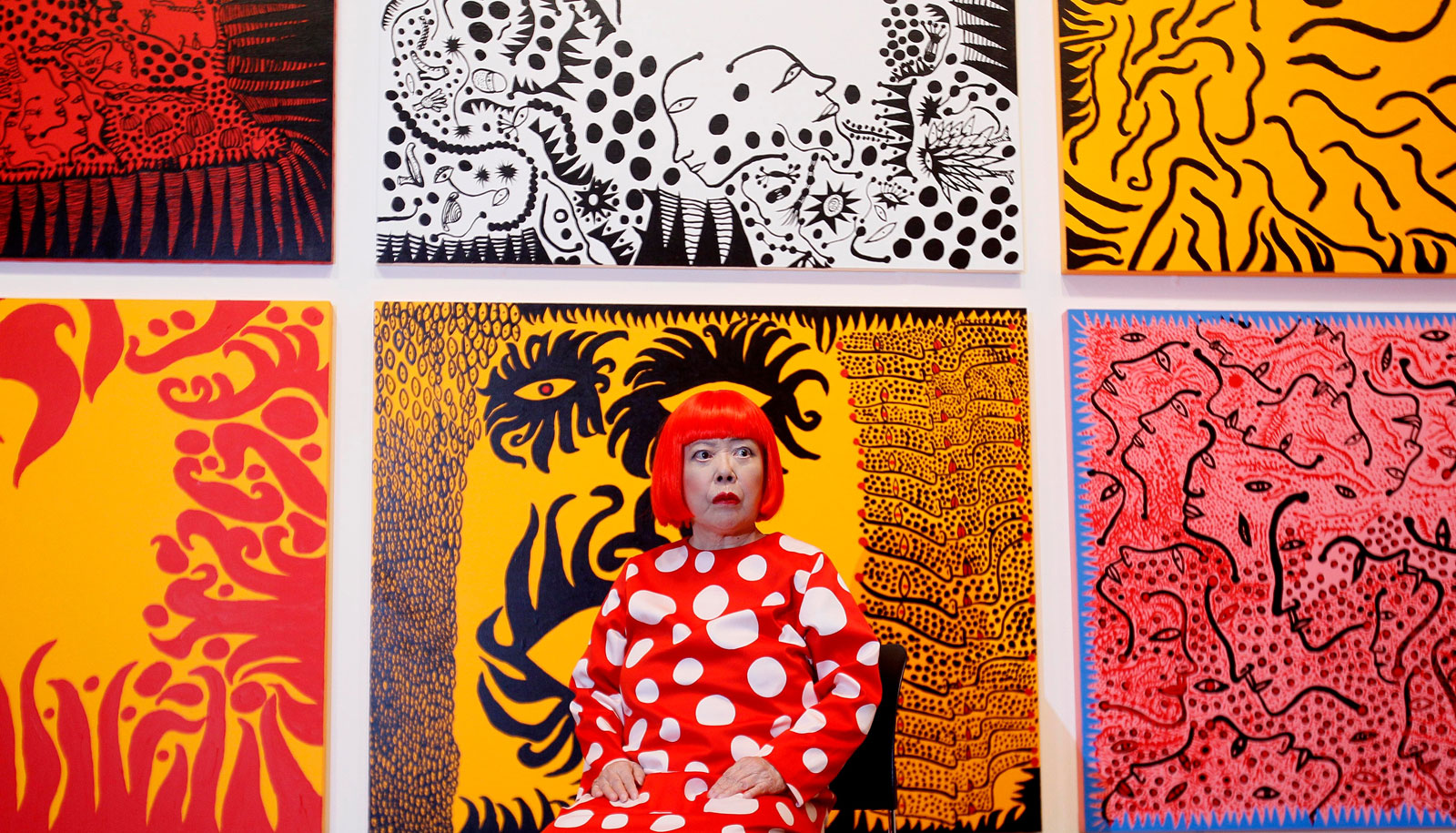
Yayoi Kusama.
Image courtesy of Kirsty Wigglesworth.
Today, Yayoi Kusama is a household name. The world’s top-selling female artist, she is renowned for her peculiar polka-dotted paintings and sculptures, which command long lines at preeminent art institutions across the globe. Like many famous contemporary artists from the last century, she is strongly associated with a unique personal style, and recognized by her bright-red wig. Despite her phenomenal success, her position in the pantheon of notable contemporary artists was anything but assured. Born in the rural town of Matsumoto, Japan in 1929, Kusama was discouraged from pursuing a career; rather, she was encouraged to marry and start a family. Frustrated by the constant efforts to suppress her artistic aspirations, she wrote to the already famous Frida Kahlo for advice. Kahlo warned that she would not find an easy career in the US, but nevertheless urged Kusama to make the trip and present her work to as many interested parties as possible.
Unsurprisingly, Kahlo’s advice was accurate. After traveling to New York, Kusama’s early work received praise from notable artists Donald Judd and Frank Stella, but it failed to achieve commercial success. Her work also attracted the attention of other renowned artists, who were able to channel ‘inspiration’ from Kusama’s work right back into the male-dominated New York art market. Sculptor Claes Oldenburg followed a fabric phallic couch created by Kusama with his own soft sculpture, receiving world acclaim. Andy Warhol repurposed her idea of repetitious use of the same image in a single exhibit for his Cow Wallpaper. Most blatantly, after exhibiting the world’s first mirrored room at the Castellane Gallery, Lucas Samaras exhibited his own mirrored exhibition at the Pace Gallery only months later. Needless to say, these artists did not credit Kusama for her work and originality. This ultimately caused a despondent Kusama to abandon New York and return to Japan.
Kusama spent the next several decades largely in obscurity. The frustrations in her career resulted in multiple suicide attempts and long-term hospitalizations. However, Kusama always found a way to channel this energy back into her art, and she continued to create art in various formats as a way to heal. It was not until a 1989 retrospective of her work in New York and an exhibition at the 1993 Venice Biennale that the world truly tok notice of her work. This global reintroduction was enough to galvanize interest in her artistic creation, leading to the success she enjoys today. While it may seem just that such a talented artist would eventually receive recognition for her work, this is not always a given and Kusama’s near erasure from the art world should not be discounted.
The Gendered Art Market Divide
In today’s art market, artists, collectors, dealers, and museums are making a concerted effort to fight this type of erasure. Kusama stands as a beacon to others, demonstrating that female artists can reach the pinnacle of their profession. However, it remains an arduous career path for many. Statistical analysis confirms that female artists are underpaid and underrepresented in both the primary and secondary art markets. For example, compare the highest price paid for a work by a living artist by gender: Jeff Koons’ Rabbit sold for $91.1 million in 2019; while Jenny Saville’s Propped sold for $12.5 million that same year, a mere 14% of the Koons’ price. Some of this disparity can be explained by the difference between men and women’s treatment in the workplace generally, but the art world is also subject to a number of particularities. Attributed to a host of causes, perhaps none is more prominent than women’s almost total exclusion from studio art until the 1870s. The art world has existed in this environment for so long that its institutions and relationships now mechanically reinforce the disparity between genders: women are less likely to receive recognition and training, and buyers are less interested in art created by females. The interest in female-made art is also disproportionality concentrated on its biggest names; the top five best-selling women in art held 40% of the market for works by women auctioned between 2008 and 2019. It has become a self-sustaining cycle that can only be broken through deliberate and effective action.
Initiatives Supporting Female Artists
Artists and galleries have been working to shine a light on the current landscape of inequality in the market. Groups like the Guerilla Girls have used their cultural status and notoriety to vocalize issues regarding sexism, racism, and other types of discrimination still rampant today. This type of radical-meets-reformer message resonates with a newer generation that is more vocal about addressing discrimination, and frustrated by the seemingly lackluster efforts to minimize their impact on society. In honor of Women’s History Month, several galleries have announced shows dedicated to addressing some of these issues. The Equity Gallery is presenting “FemiNest,” a collection of works by female artists centered around the literal and metaphorical ideas conjured by the idea of a “nest.” The show explores in sculpture, textiles, painting and other media the new spaces that have opened for women in recent decades and their practical and spiritual impact for women. The Brooklyn Museum has announced a retrospective of Marilyn Minter’s work titled “Pretty/Dirty” aimed at challenging traditional notions of feminine beauty. Featuring more than three decades of work, the show will track Minter’s progress throughout the 1970s, 80s, and 90s. The show is also part of a larger series of ten exhibitions by the Brooklyn Museum dedicated to the subject: “A Year of Yes: Reimagining Feminism at the Brooklyn Museum.” Lastly, the Zimmerli Art Museum will feature an exhibition of works by the Guerilla Girls and other female artists who have worked to depict women’s unequal treatment in the art world, “Guerrilla (And Other) Girls: Art/Activism/Attitude.” (For more information about these shows and others addressing similar issues, see here.)

Do Women Have To Be Naked To Get Into the Met. Museum? (1989), Guerrilla Girls. Image via the Met.
Although artists and art institutions have just begun the work of winding back centuries of discrimination, there is evidence that their work is already affecting the market. The percentage of female-generated artwork in the secondary market is increasing from year to year; from 2008 to 2018, the market more than doubled from $230 million to $595 million. Similarly, representation of women at major art shows is steadily, if inconsistently, increasing as well. This subtle shift in the market has been attributed at least in part to a new class of art purchaser: independently wealthy women, whose capital is self-made rather than inherited or shared via marriage. This novel source of demand is less sensitive to the traditional pressures of the market and is helping to fuel demand for works by female artists. Women’s History Month is an opportunity to reflect on the tremendous progress made by remarkable individuals in the art world, and to also contemplate the ripe opportunities that still lie ahead.
by Amineddoleh & Associates LLC | Feb 13, 2024 |
For most New Yorkers, the words “Grand Central” may not evoke feelings of romance. However, this historical terminal is more charming than it appears. One of its most endearing hidden gems is a tiny alcove meant to give couples a place to meet up – and share a romantic kiss – after long-distance travel.

Grand Central Terminal. Image via Jakun Halun.
The Kissing Gallery
The Kissing Gallery at Grand Central Terminal, located inside the Biltmore Room, is the place to be this Valentine’s Day. The Kissing Gallery is what it sounds like – a snug alcove in the Biltmore Room, tucked away in largest railroad station in the world, and specifically designed for kissing. It is the place for lovers to steal away from the crowd for a kiss.

The Biltmore Room in Grand Central. Image via gothamist.com.
(Psst..did you know? Grand Central Terminal refers to the terminal line, which means trains stop at Grand Central Terminal. Grand Central Station refers to the subway station inside GCT. Those subway lines pass through GCT).
The origins of the Kissing Gallery date back to Grand Central Terminal’s (GCT’s) earliest days. When GCT opened in 1913, it was a much more organized animal than the spastic craziness modern commuters encounter today. In the beginning, the terminal was carefully planned and designed to facilitate the flow of both long-distance and short-distance travelers.
Early in its operation, staff noticed that foot traffic was constantly jammed in areas where long-distance trains emptied out. The problem? Lovers’ reunions were causing literal standstills on pedestrian walkways.
It’s an adorable slice of New York City history: kissing caused traffic jams, so city dwellers devised an imaginative solution. This solution was simple: create a special room solely for kissing.
Shockingly, this worked, and meeting up in the Kissing Gallery post-transit with a special someone was considered the norm. Traffic jams caused by kissing all but stopped. (Nowadays, pedestrian traffic hold-ups are due to the invasion of the selfie takers. Unless, of course, the hold-up takes place on the field after Super Bowl LVII. Then, foot traffic has stopped to make way for Taylor Swift and Travis Kelce’s showstopping, celebratory kiss).

The Biltmore Room in the 1950’s. Image via Boris Klapwald.
Even so, a public kissing room was a bit racy for the 1910s. To alleviate any possible discomfort among other travelers, a few ground rules were instituted. The two major regulations were (1) each kiss may last a maximum of five seconds, and (2) absolutely no tongue.
(These rules were actually written in the manual and were readily enforced by GCT staff).
It’s a cute story – The Kissing Gallery, with history that stretches back nearly 120 years, is one of the many secrets and surprises of GCT that have been preserved. GCT’s preservation is due to historic preservation laws – and a major Supreme Court case.
Penn Central Transp. Co. v. New York City (1978)
In the late 1970s, Penn Central (the business owners of GCT) began to make plans for a major renovation to the terminal. Penn Central hoped to install a 50-foot skyscraper atop the historic building. From a business perspective, such an ugly installation made sense. From an aesthetic perspective, it was madness. Thankfully, New York City prevented Penn Central from starting the job. In response, Penn Central sued, arguing that the City’s refusal to let the project go forward amounted to an unconstitutional taking.
A bitter legal battle ensued, and eventually made its way to nation’s highest court. Penn Central’s primary argument for the construction was their company’s bottom line. Penn Central argued economic hardship, should the terminal continue to be run in its present condition. The company also showed the Court accounting documents to demonstrate how much more profitable the terminal would be under the proposed changes. However, the financials alone were not enough to convince the Court.
The Court acknowledged that the proposed transformation would increase the company’s bottom line. But, the Court said, GCT was making Penn Central a considerable profit as it was. Moreover, GCT was already legally a historic building under the Landmarks Act. This was not the determinative factor in the Court’s ultimate decision, but the justices took it into account. The Court said that Penn Central should not have reasonably expected to be able to initiate such a dramatic construction project anyway, because GCT had already been given historic designation under the Landmarks Act.

Grand Central Terminal. Image courtesy of NannFilms, used with permission.
Finally, the Court pointed out that the restrictions that come with owning a historic landmark may seem burdensome, Penn Central also benefitted from the restrictions placed on neighboring properties that prevented certain land use changes. And then (to make matters worse for Penn Central), it turned out that the accounting documents (provided by Penn Central to show economic hardship) were misleading, and did not give an accurate depiction of the company’s profits and losses (whoops).
In the end, the Supreme Court ruled in favor of the City, and stopped Penn Central from breaking ground on their renovation – a decision that buoyed the hearts and souls of art and cultural heritage experts around the world. Not only that, many notable New Yorkers (including a one Jackie O.) were against the destruction of such an important piece of New York City history. Possibly even judges on the Supreme Court were not immune to her charms.
Grand Central School of Art
The Kissing Gallery is not the only romantic secret hidden within the Grand Central Terminal.
A little-known fact about Grand Central is that the seventh floor of the East Terminal once housed the Grand Central School of Art. This was an art school in New York City with instructors who taught skills across artistic disciplines, including sculpture, mural painting, illustration, and costume design.

The Betrothal II by Arshile Gorky (1947). Image via oceansbridge.com.
The Grand Central School of Art (not to be confused with the modern-day Grand Central Academy of Art, which is a wonderful art school on Long Island), was one of the largest and most prominent art schools in the city at its prime. The school’s success (and notable alumni) befits the institution’s illustrious founders: Edmund Grecean, Walter Leighton, and John Singer Sargent.
Who would have thought that John Singer Sargent had the time and energy to open a prestigious art school, on top of all his notable commissions for fancy socialites? In any event, he did, and he and Grecean used their art world connections to bolster an impressive faculty: Chester Beach (sculptor), Ezra Winter (muralist), Dean Cornwell (muralist), Helen Dryden (illustrator and costumer designer) and Arshile Gorky (painter), to name a few.
The school enjoyed a good 20-year history before things turned south. After a grand opening in 1923, the Grand Central School of Art sadly shuttered its doors in 1944 due to financial difficulties.
Even after the school closed, artists from around the world used the vibrant energy of Grand Central Terminal in their work. Something about the fast-paced movement, the glorious architecture, and the joyous lovers reunions must prompt artists to capture the moment with great creative aplomb.
Not convinced? Check out The Kiss by Ernst Hast (1958). The featured couple appears to be truly in love, and also seems to be breaking a few important Terminal rules.

The Kiss by Ernst Hast (1958). Image via icp.org.
The Kissing Gallery is in the Biltmore Room, folks!
by Amineddoleh & Associates LLC | Jan 23, 2024 |
Our firm is thrilled that this is Master Drawing New York’s (MDNY’s) first year with our client, Christopher Bishop Fine Art, at the helm. This highly-anticipated, week-long event is the premiere art exhibition of works on paper in the United States. Over two dozen galleries on the Upper East Side will feature rare and exquisite works on paper, in addition to some paintings, sculptures, and photographic works. The selected works range in date, with some pieces dating back to the 15th century.

Brochure cover for MDNY 2024. Image via Master Drawings New York.
Those who wish to walk the entire show (despite forecasts for rainy weather) will find that they easily meet their step-goals for the day – MDNY stretches 40 city blocks. In addition to the various exhibitions spanning the fair, several events and lectures will take place in different locations throughout the week. Those interested in attending should be sure to pick up an exhibitor map and calendar at one of several spots in the city, lest they miss out on an exclusive, once-in-a-lifetime event.
Highlights
One of the highlights of the fair comes from our very own client. Christopher Bishop Fine Art will exhibit The Pharoah’s Judgment, an exceptionally rare Spanish drawing discovered at auction in early 2023. The 16th century drawing contains tiny pin pricks throughout the pattern of the drawing. These pin pricks indicate that the pattern was replicated on ecclesiastical garments. MDNY has chosen to exhibit this work in a double-sided frame, in order to best showcase how the maker of the drawing collaborated with the embroiderers on the finished garments.This gives viewers a fascinating inside-look into artist collaborations in the 16th century.
Spirit of Partnership
Speaking of collaborations, this year marks the start of a new, great one. MDNY is partnering with The Drawing Foundation, a New York-based not-for-profit organization whose mission is to advance knowledge and scholarship about drawings. The Drawing Foundation establishes this goal through collaborations with various partners around the world. Our firm applauds MDNY, and, by extension, Christopher Bishop Fine Art, for engaging in this fresh collaboration with The Drawing Foundation. The partnership is sure to foster the newest generation of scholars, students, curators, and appreciators of artistic works on paper.
Collaboration – among artists, galleries, collectors, and audiences – hits at the heart of MDNY itself. The events this week are not to be missed, not only because they are a chance to experience gorgeous art, but because they present an opportunity for the international art community to come together in scholarship and art appreciation.
No one says it better than Christopher Bishop. “All of us who work with drawings — museums, dealers, collectors, and historians alike — are invested in seeing that the joy of the study of drawings is passed on to new generations. This can only be done by knitting the community together ever more strongly and introducing new audiences to the fair.”
by Amineddoleh & Associates LLC | Oct 31, 2023 |
Good news, thrill-seekers! Here at Amineddoleh & Assoc., not only do we provide exquisite legal services for our clients, we also know where to find a good, real-life scare. Our secret? Follow the haunted art!
Read on for our recap of our firm’s top haunted art-themed blog posts. Then, book a ticket to see the haunted art in-person. No tricks here, each destination is a true, Halloween treat.
Witch Way to the Party?
In this recent blog post, our firm traveled to Asheville, NC to get a glimpse at America’s Largest Home – and one of the most haunted. Click the link for all the details on this spooky mansion, including its most famous ghost-in-residence. Not only that, this historic home has a strange room known as the Halloween Room for visitors to experience, plus its own secret connection to protecting American art from Nazi air-raids in WWII. As if that weren’t enough to encourage a click, this post also has dazzling photos of Asheville’s gorgeous fall foliage.

Biltmore House in Autumn. Image via R.L. Terry at Wikimedia Commons.
The Ghoulishly Gory Frescos in Rome’s Santo Stefano Rotondo
Ever see art so gory it incites a physical response? Click here for more info on this real-life syndrome, known as Stendhal Syndrome, in which grotesque art and cultural heritage causes viewers to have palpitations of the heart. For those wanting to experience the syndrome in real-life, look no further than Santo Stefano Rotondo in Rome. While most tourists on a Roman holiday select beautiful frescos at the Vatican, those who venture to Santo Stefano will see a different sort of religious art. Go for the scenes of torture, stay for the bloody depictions of senseless violence. Plan to go before lunch, or else risk spilling the contents of your own stomach at the foot of these cultural works.

Gory frescoes covering the walls of the church. Image courtesy of Leila Amineddoleh, used with permission.
Cursed Art, from Statues to Paintings
Anglophiles, unite! The National Gallery in London is home to one of the most famous paintings in the world. However, this work is not famous for its artistic qualities (though they are divine). Rather, The Rokeby Venus is better-known for its ability to cause viewers to lose their minds. Click here to read all about this painting’s astonishing – and potentially cursed – provenance. The strange stories behind The Rokeby Venus illustrate how all aspects of a work’s life – including whether or not it is cursed – create its provenance. No matter what your opinion is of The Rokeby Venus’ alleged curse, the documented history of strange occurrences attributed to its ownership has become an important part of the work’s provenance.
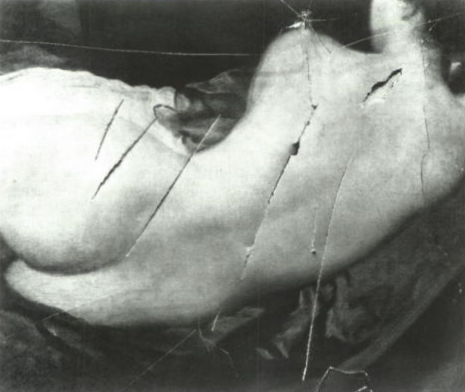
The slashed Rokeby Venus. Image via artinsociety.com.
Haunted Happenings: The Law of Ghosts and Home Sales
If the average Airbnb isn’t scary enough this season, consider visiting a house that’s actually haunted. More and more people are reporting ghosts in domestic settings – and not always friendly ones. Trouble ensues when the place the ghost calls home is up for sale. Lawyers may be faced with the question: is a ghostly presence a condition that must be disclosed prior to sale? Would a reasonable family purchase a house that comes with a frightening ghost? Read more here to discover the actual laws that govern when a family’s new home comes with an unexpected side of ghost.
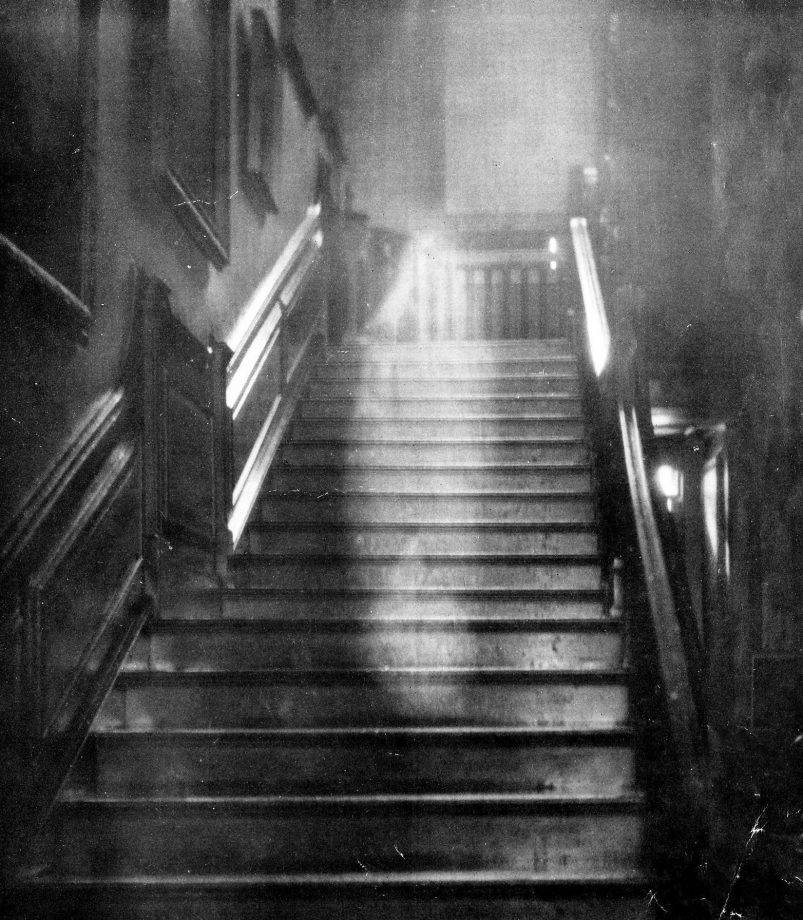
Famous ghost photograph of the Brown Lady of Raynham Hall, originally taken for Country Life (first published in December 1936).
Horrifying Provenance of Monster Manuscripts
This post provides two monstrous holiday destinations in one spooky swoop: ties to Mary Wollstonecraft Shelley’s Frankenstein can be found in both New York City and Oxford, England. Online versions of Shelley’s copious notes and edits for the story can be found on The Shelley-Godwin Archive’s website through the New York Public Library. To pay a visit to the originals, travel to Oxford, where the original transcript are held as part of the Abinger Collection in the Bodleian Library. If that weren’t reason enough to visit Oxford this time of year, stop by Christ Church College for the Harry Potter-esque tour of the storied grounds. Glimpse the inspiration for the wizarding world’s tall towers and cavernous halls on the college campus. Who knows – wizards also might be walking the grounds, masked in their muggle clothes.
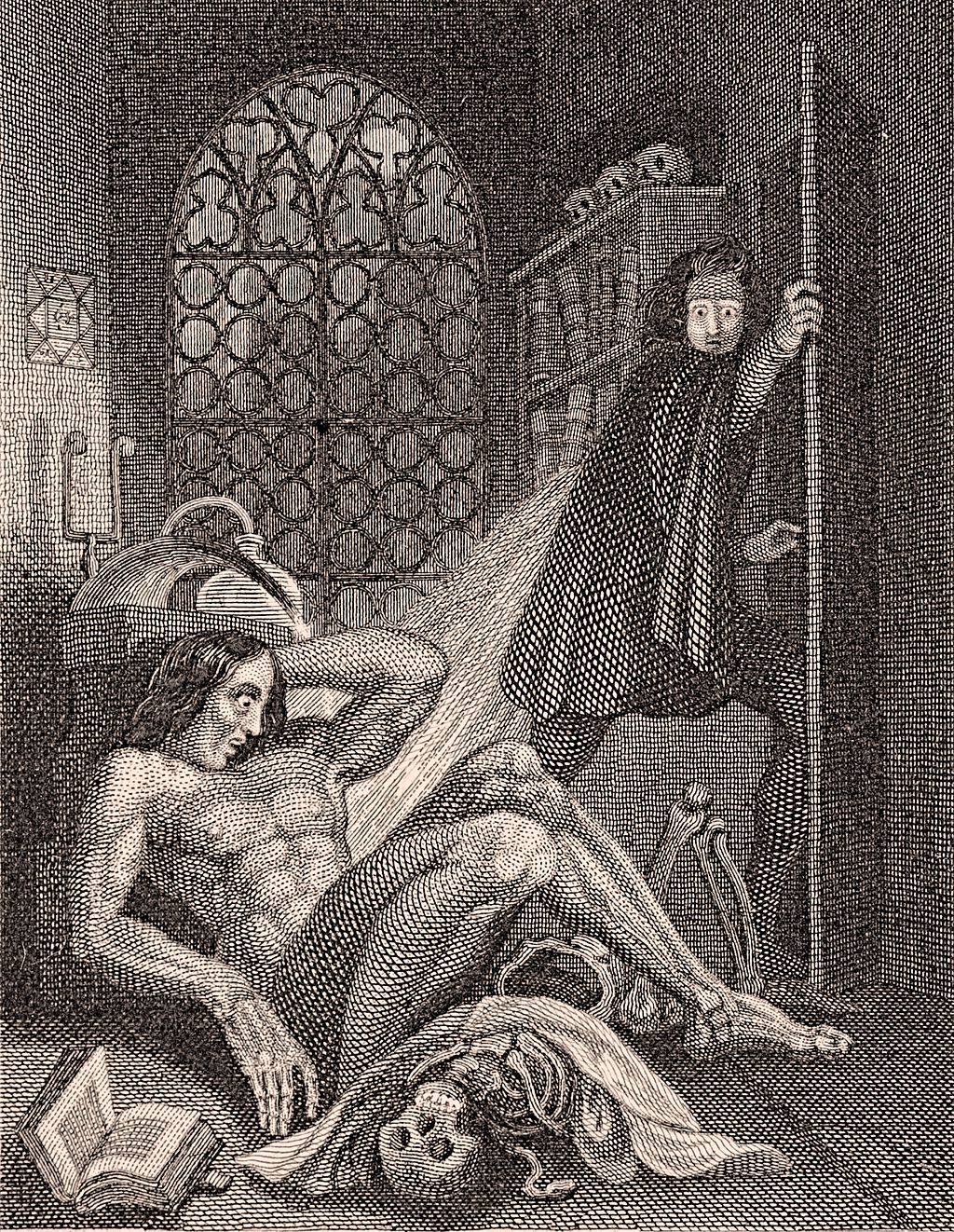
Illustration from the frontispiece of the 1831 revised edition of Frankenstein, published by Colburn and Bentley, London 1831.
The Cat’s Meow: Feline Art Lovers
Word on the street is that the husband of our firm’s founder is dressing as a cat for the second consecutive year this Halloween. While we can neither confirm nor deny the Halloween costumes of our firm’s families (or whether or not, in fact, the members of those families were given the freedom to select their own costumes, or if they were selected for them by their young daughters), click here for a post inspired by our culture’s love for cats in art. Thinking of dressing as a cat this year? As our founder’s husband may say, ‘tis the season!
On behalf of Amineddoleh & Associates, we wish you a safe and Happy Halloween this year!
by Amineddoleh & Associates LLC | Oct 26, 2023 |
Congratulations to our firm’s founder, Leila Amineddoleh, who successfully chaired the 15th Annual NYCLA Art Law Institute: New Insights in Art Law. This annual conference is one of the most highly-anticipated and innovative events of the year.

Peak fall foliage in NYC’s Central Park, just in time for the Conference. Image via Central Park Conservatory.
This year’s was no exception. The two-day event highlighted leading experts and voices in the our industry. Read below to get a glimpse of how panelists dove into the hottest topics facing artists and lawyers today – they dove into a wide array of topics, including evolving issues in the art market, art and cultural heritage law, and intellectual property.
New Developments, Dispute Resolution, & Art World Conflicts of Interest
Day 1 opened with a smash-hit panel. The panel, featuring Paul Cossu, Adrienne R. Fields, and Claudia Quinones, tackled new developments in art law and intellectual property. One highlight from this panel was the intersection of AI-created art and copyright law. A takeaway was that the U.S. Copyright Office tends to make decisions related to AI-created art based on whether AI was used merely as a tool, or whether AI was the true author.
Next, Gabrielle C. Wilson moderated a fascinating panel on resolving art disputes. The panel pondered the critical considerations and alternatives when resolving art disputes. This panel presented attendees with multiple, practical paths to use when dealing with these controversies. In some situations, art attorneys may find greater success by encouraging negotiation between parties, rather than pursuing litigation. As a whole, this second panel was a good reminder for art lawyers to continue to lean on their specific expertise in the art world to help both side achieve a just and equitable solution.
Finally, Katherine Wilson-Milne moderated a panel on art world conflicts of interest. The panel explored ways to approach these conflicts, including some suggestions for innovative paths forward. This panel encouraged participants to broaden their perception as to where art world conflicts may come from in subsequent years. With so many aspects of the cultural, financial, and political climate in flux, the art industry is being directly and indirectly impacted. It is essential for attorneys to be aware of new developments in art world conflicts of interest, and ways to best address them as they arise.
Title and Authenticity, Broken Promises, & Artist Residences
Day 2 narrowed the Conference’s focus even more precisely. The day started off with our firm’s own Yelena Ambartsumian’s presentation with Claudia Quinones. The two gave thoughtful insight and wisdom on issues surrounding title and authenticity. One highlight from Claudia’s portion included the latest developments in Nazi-looted artwork. She drew attention to the most essential cases to watch in the coming months, and provided great detail as to the specific laws at issue in each case.
Yelena then dove into powerful issues regarding cultural heritage. She brought specific attention to Armenian cultural heritage, and the current risk for destruction of such treasures. Yelena also explained the legal paths the Republic of Armenia has taken to protect their cultural heritage, due to a lack of UNESCO involvement. She also gave phenomenal insight into the hot top of authenticity issues. One takeaway from that aspect of her presentation is that, if there are reasons to be skeptical about the authenticity of a work of art, it is a good idea for the attorney to explore those suspicions!
Next up, our founder Leila moderated a fascinating panel on the enforceability of promised gifts and what happens when circumstances change. The length of time between the time the gift was made, and the time the gift is executed, was a major theme in this panel. The panel also parsed through the diverse scenarios that arise when receiving monetary gifts versus physical collections of art. In terms of physical artwork, the cost of conservation was also highlighted as an important factor in whether or not a museum or institution is even able to properly receive a certain gift. This point is especially poignant in the industry’s current climate, as costs of conservation continue to rise alongside other financial needs of leading institutions.
Melissa Passman wrapped up the day by moderating the final panel of the Conference. This closing panel explored artist residence issues, and how to navigate founder and participant relationships. One takeaway was that the resources made available to artists in these relationships tend to drive the residency as a whole. As a result, it’s important for attorneys involved to be aware of the specialized spaces and studios that may be necessary. Otherwise, it would be impossible for the artists to work and fulfill the terms of their residencies. Another takeaway was that tax laws tend to dictate what non-profit organizations are able to accomplish in these relationships. Because this could complicate artist payment in residencies, it is necessary for lawyers working with these clients to be well-aware of tax obligations, and to make that a driving factor in negotiating agreements.
Another great year!
In all, attendees experienced two action-packed days of practical advice and innovative guidance. Our firm commends all of the presenters for their hard work and fascinating presentations. We look forward to this conference each year, and this year’s was truly a celebration of the best, boldest, and brightest minds in our ever-evolving field.
Let the record stand that peak fall foliage in Central Park has its perks, but the real highlight of October in NYC is the Annual Art Law Institute.
P.S. Missed the Conference? Get in touch with NYCLA here to purchase the recording when it is released.


















